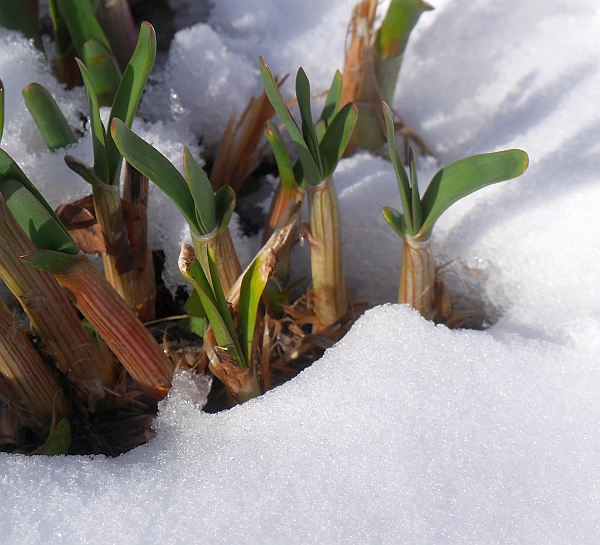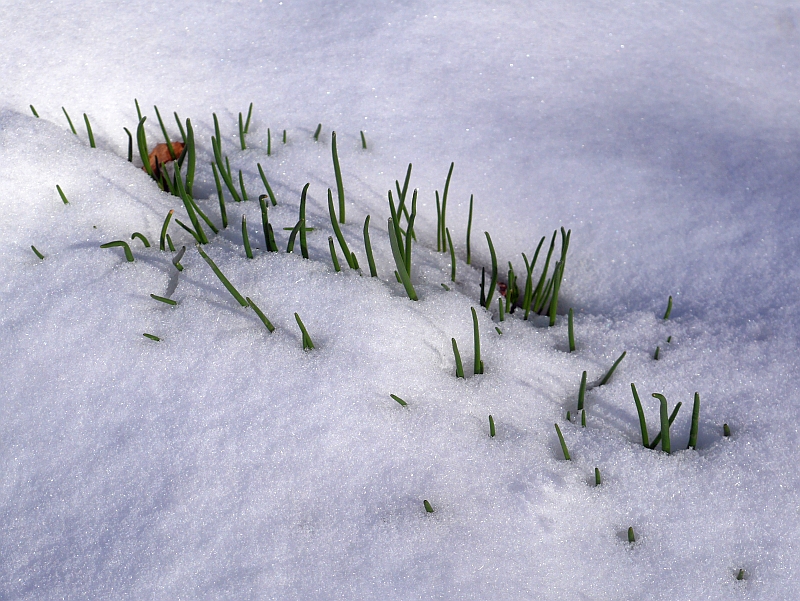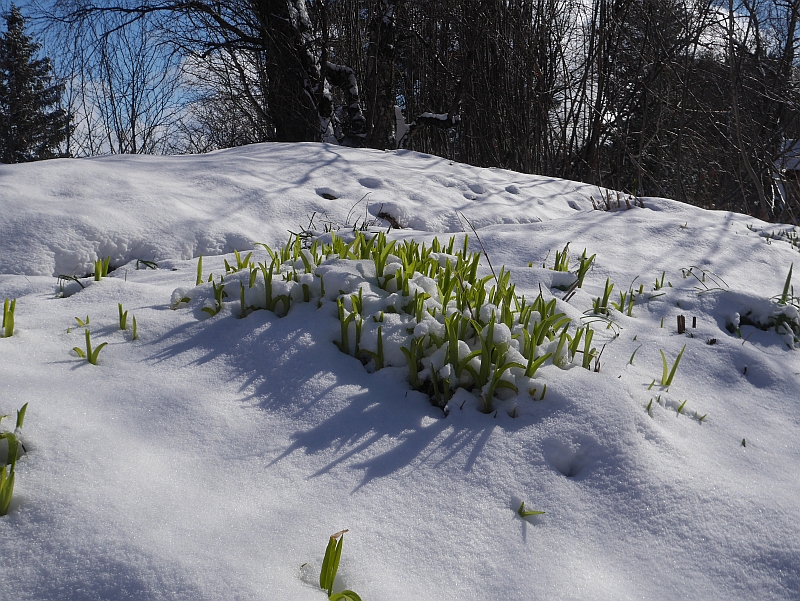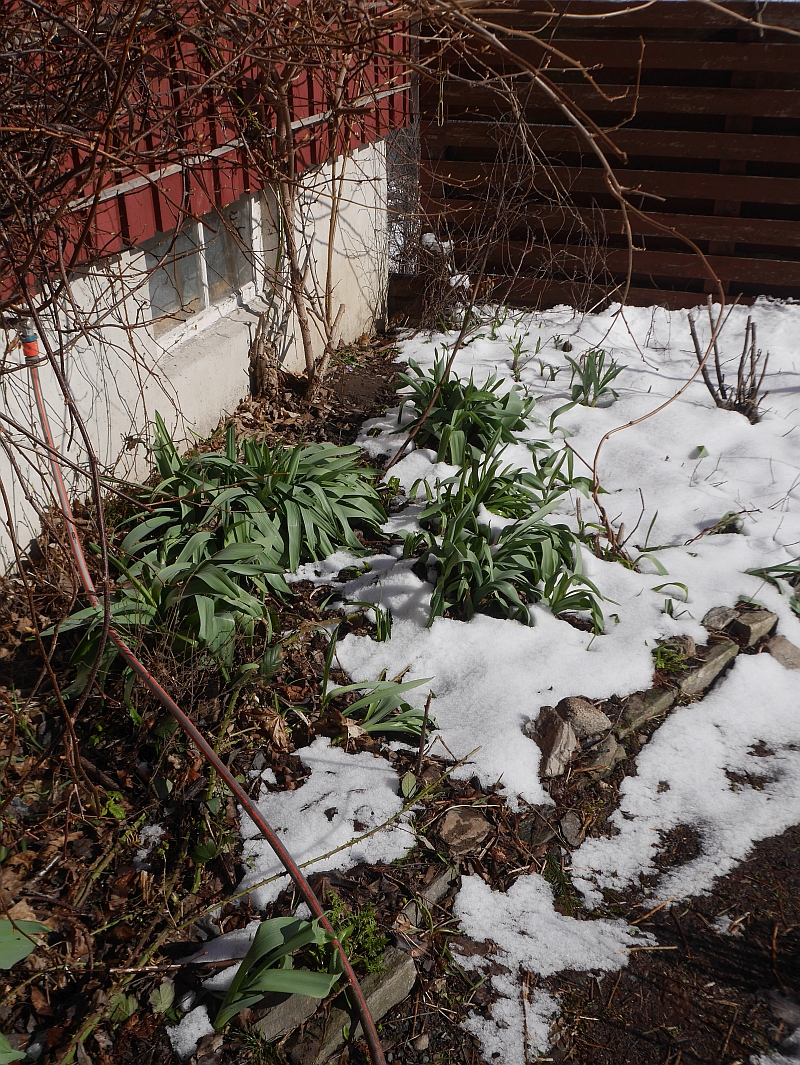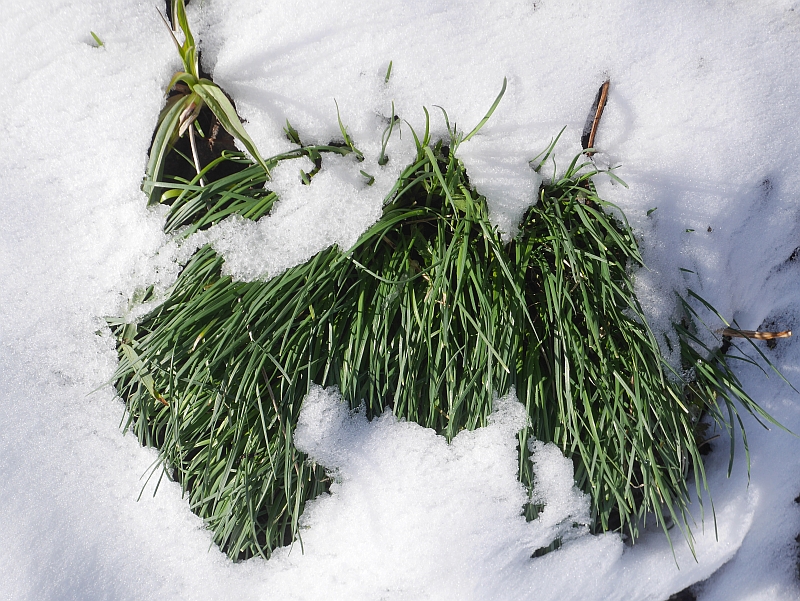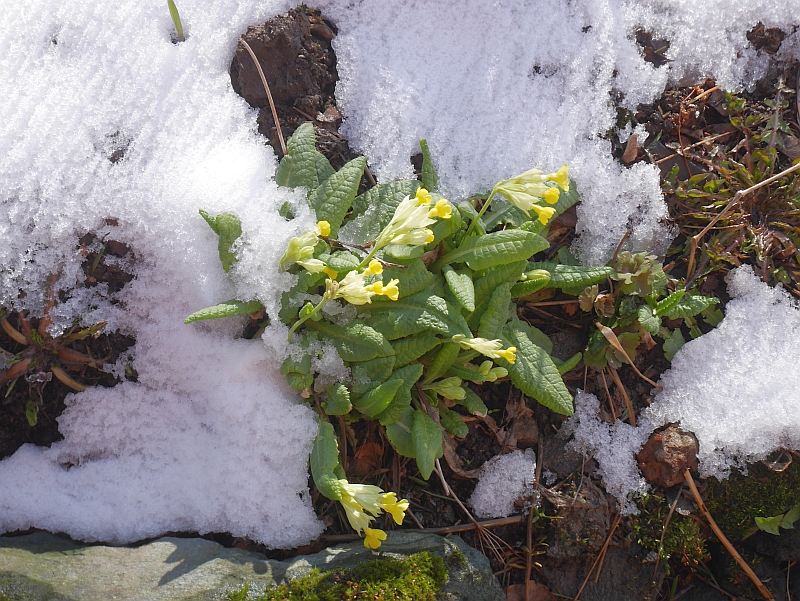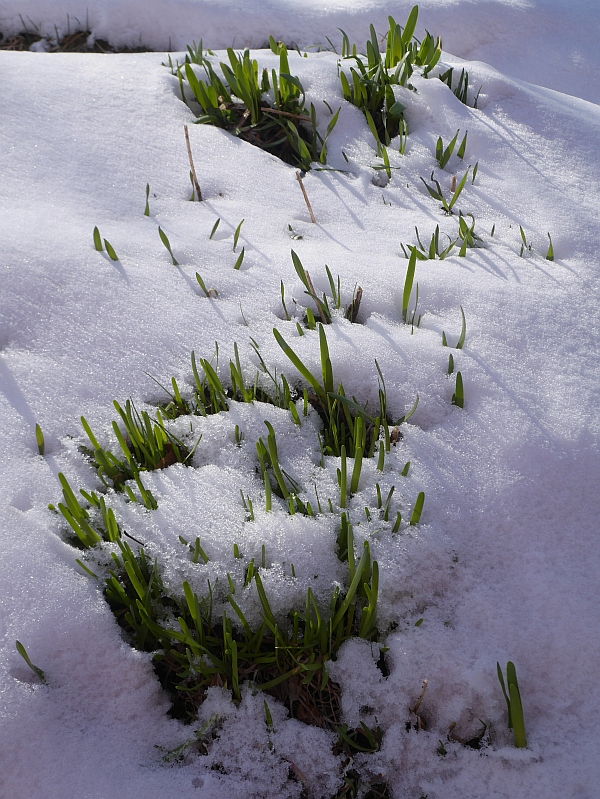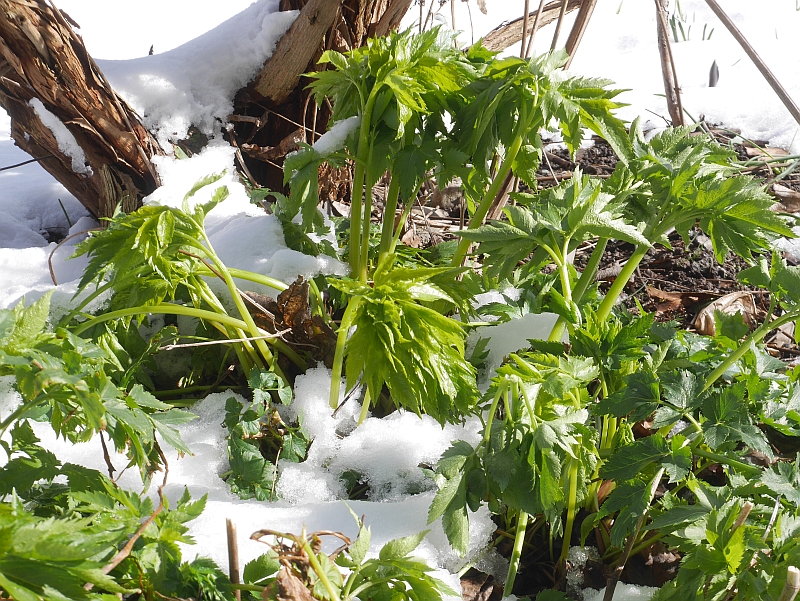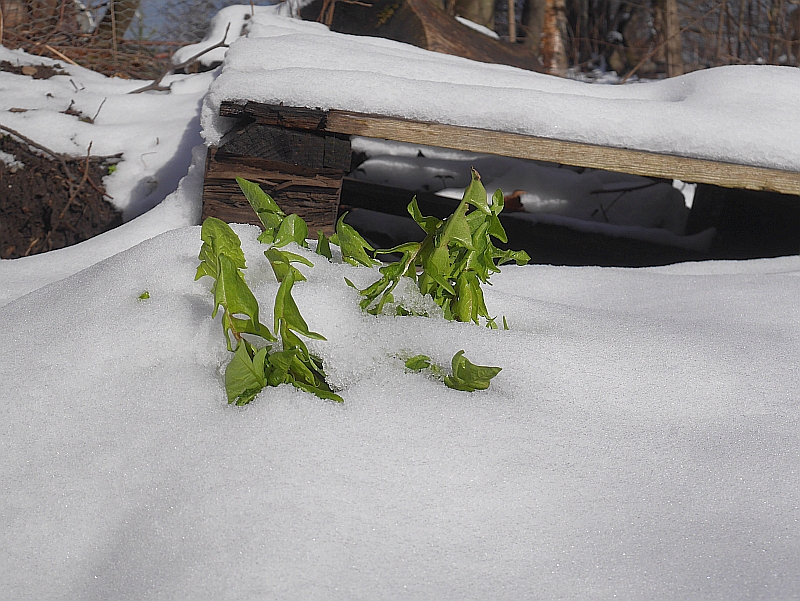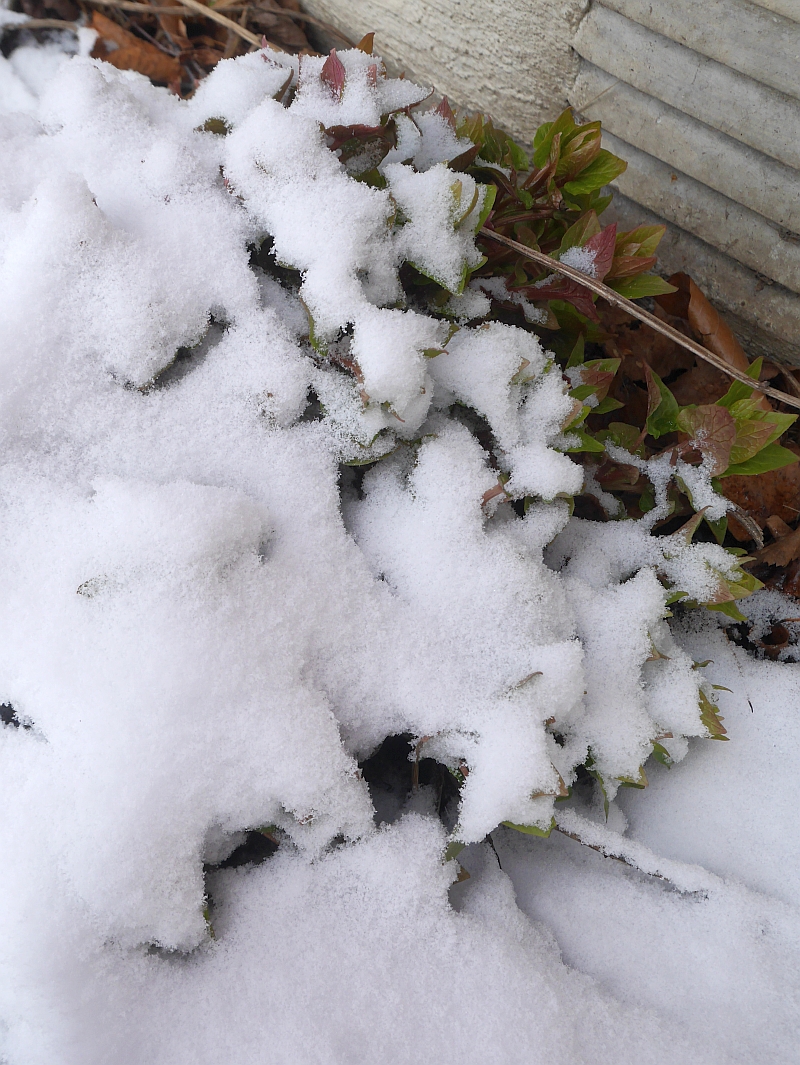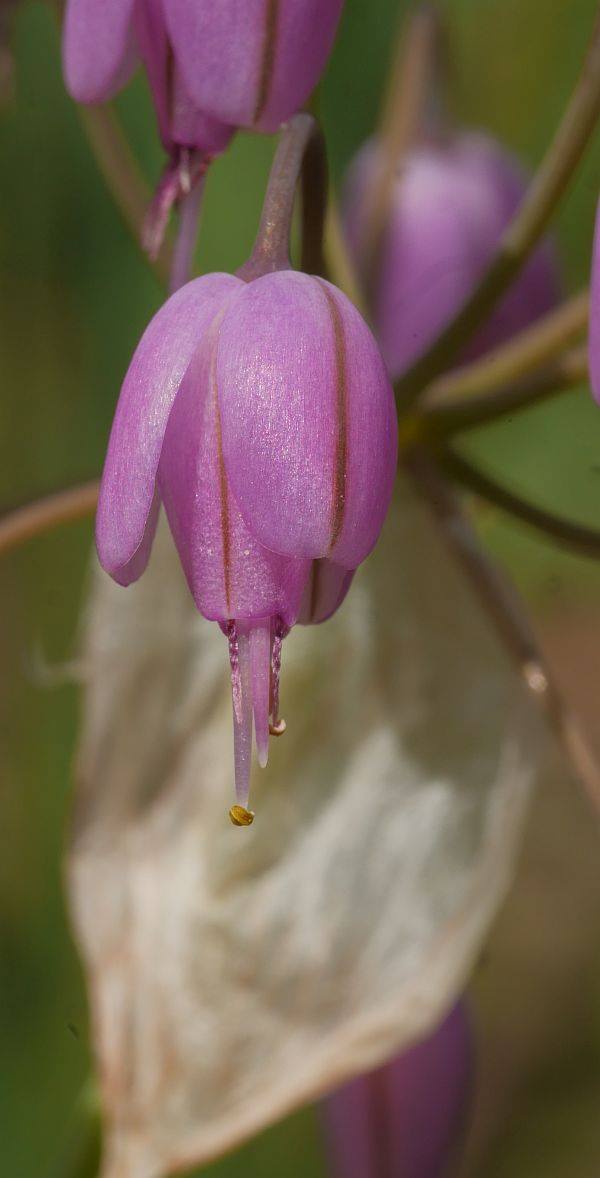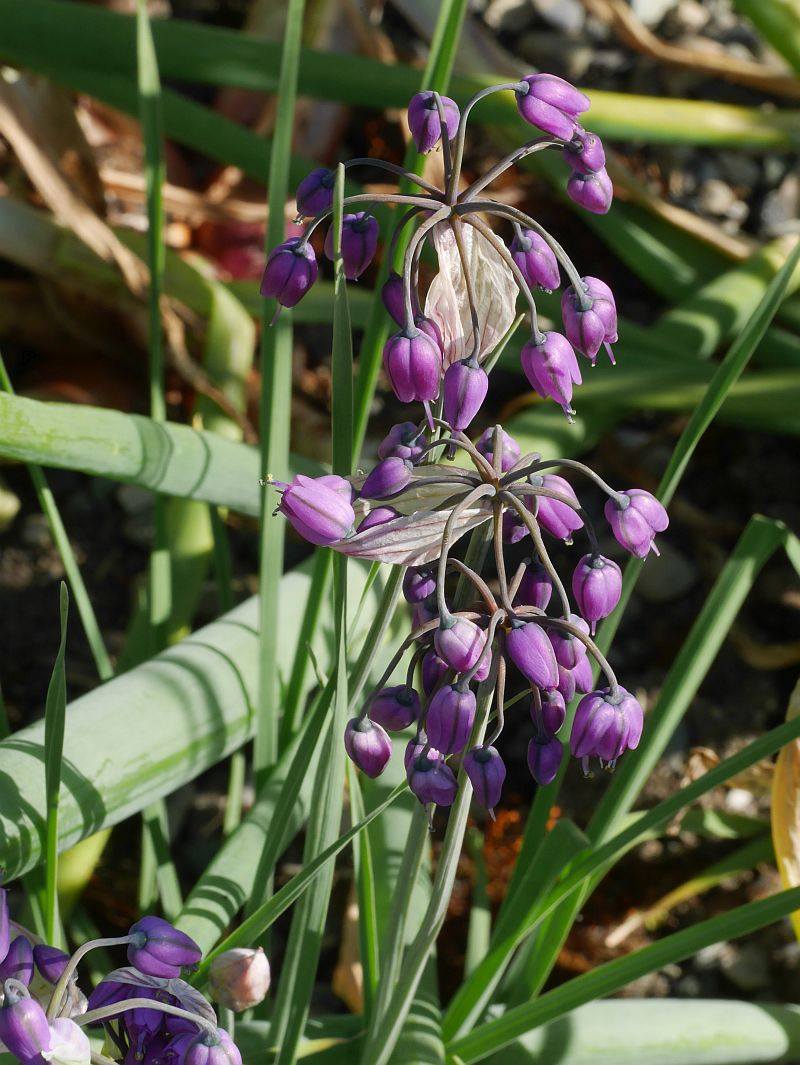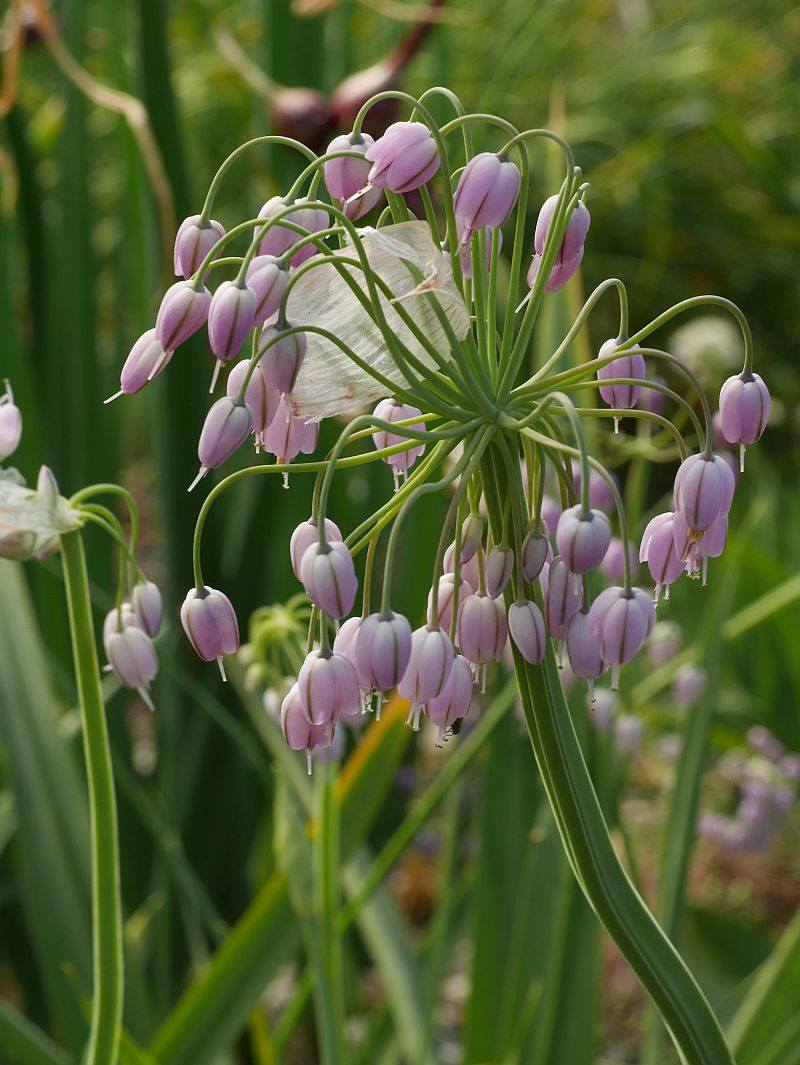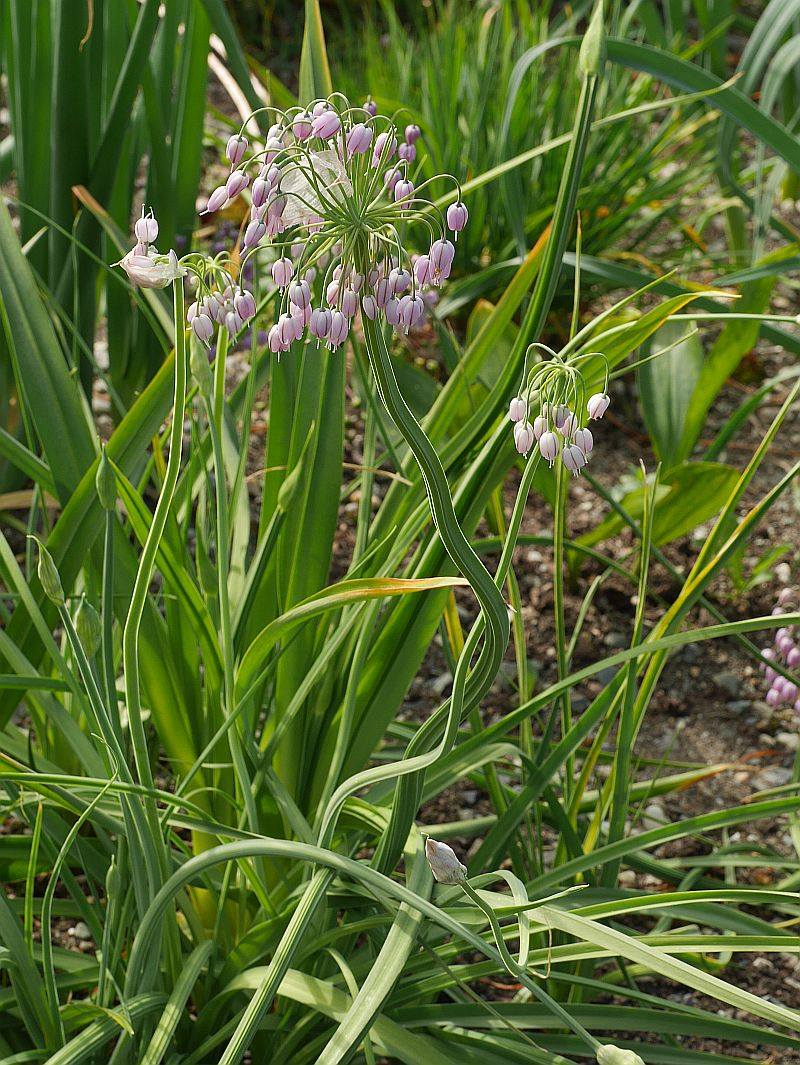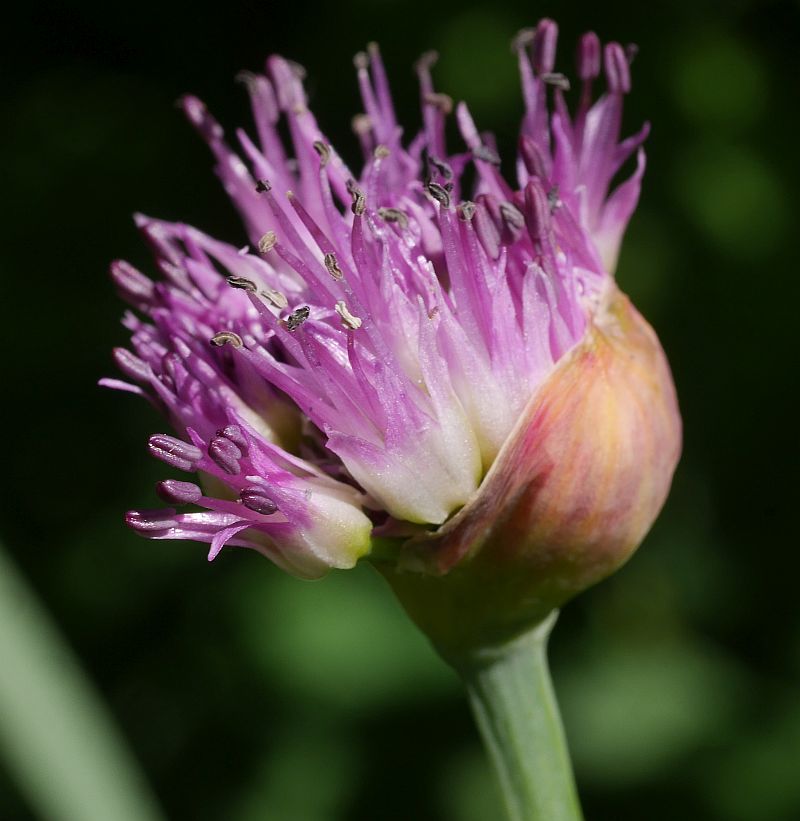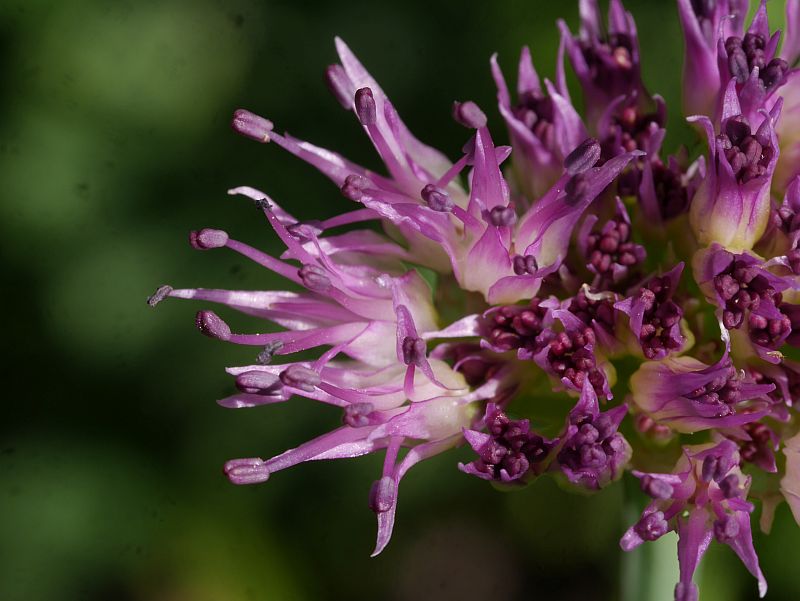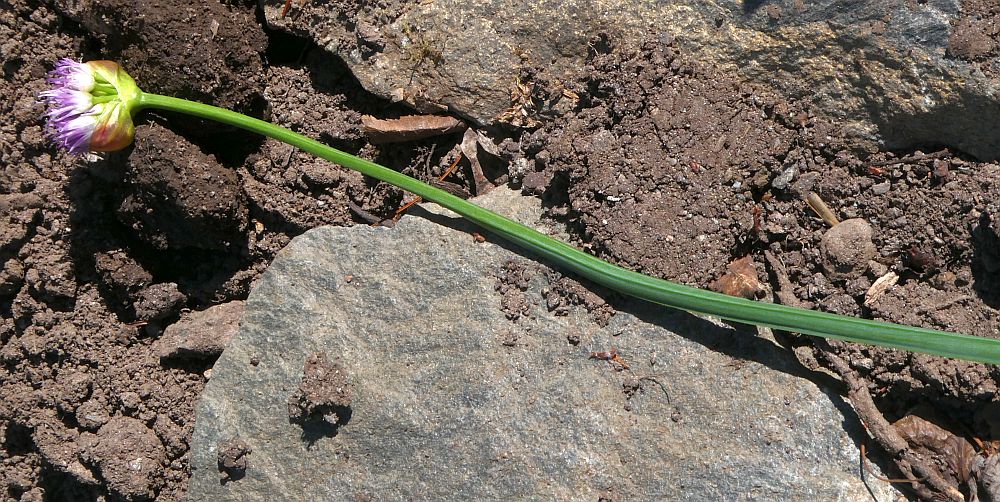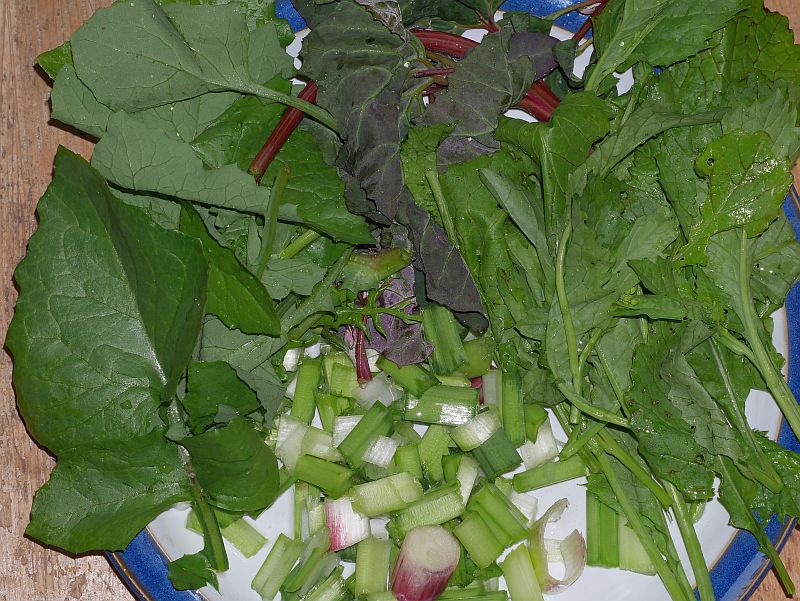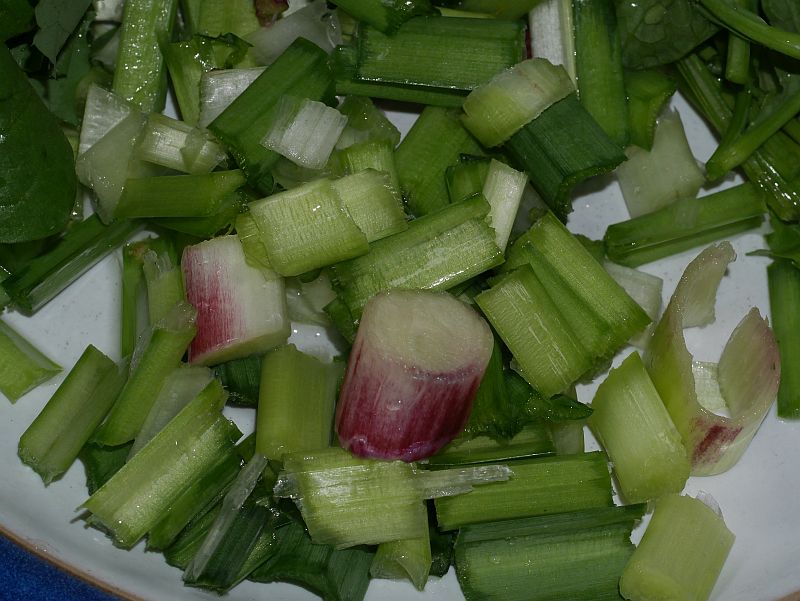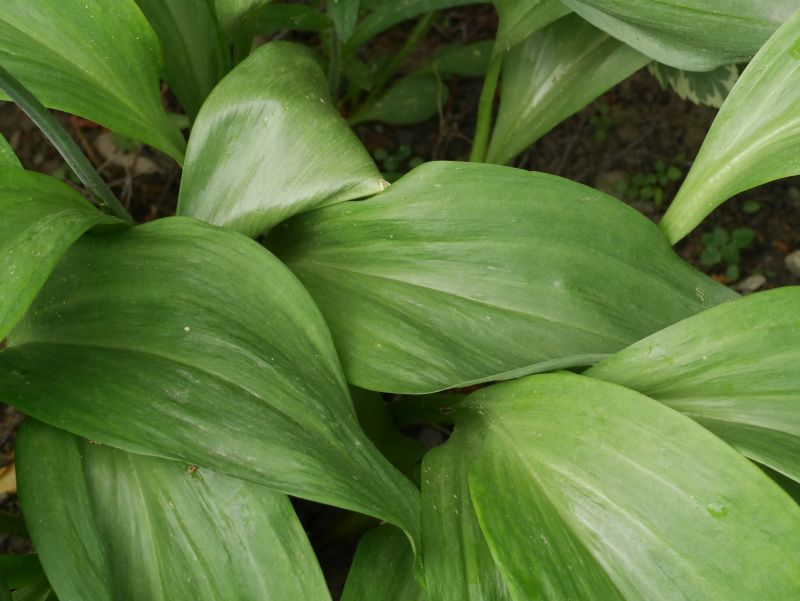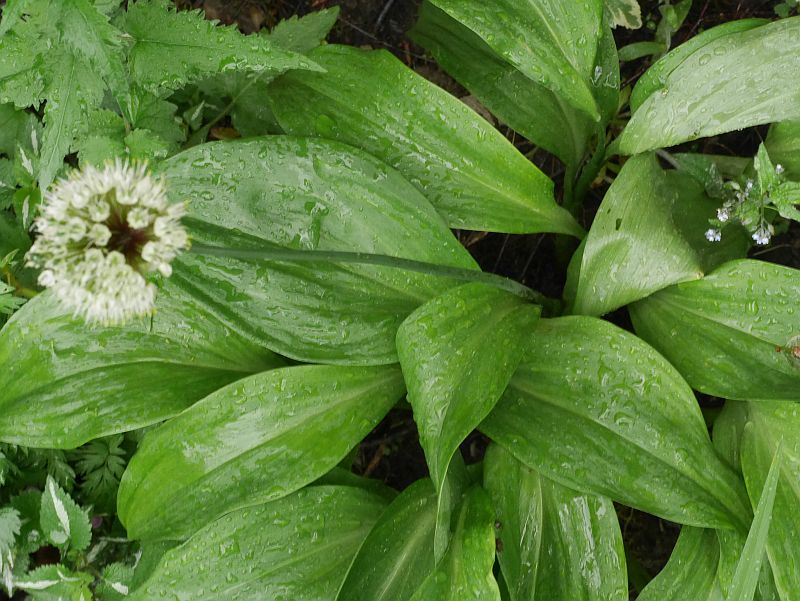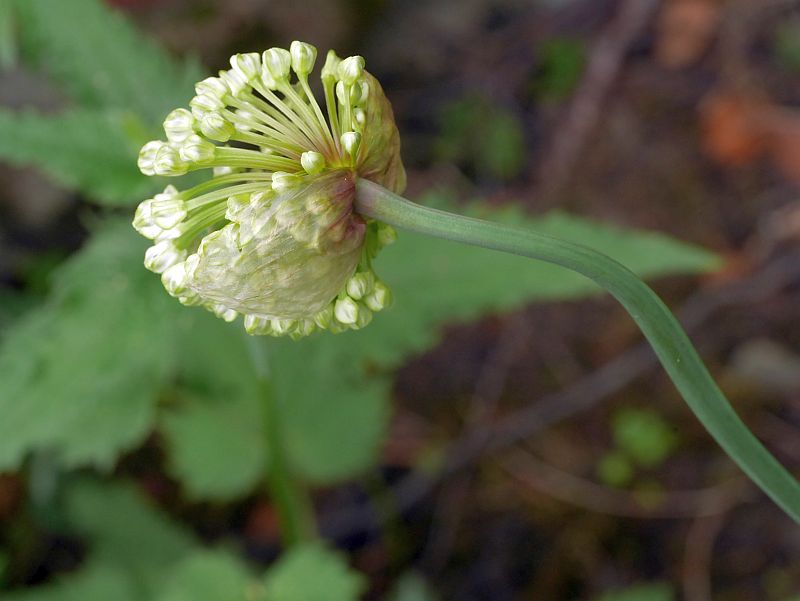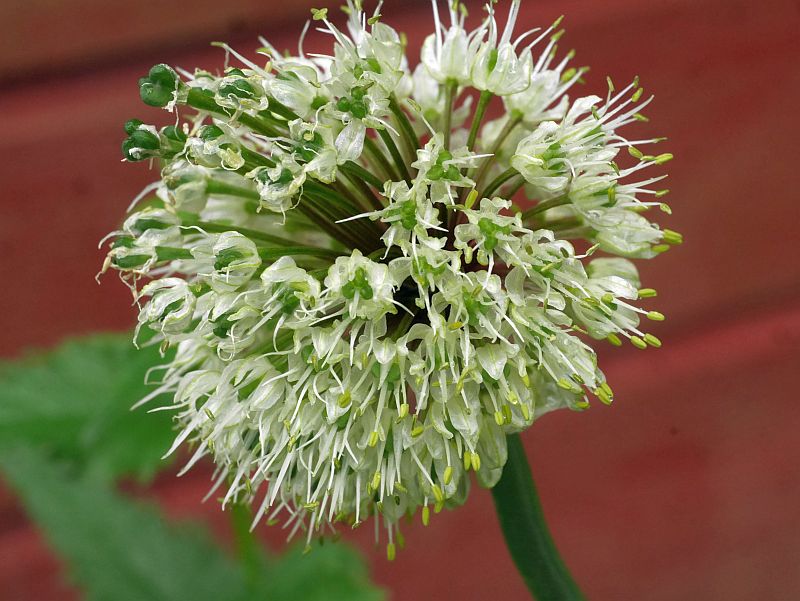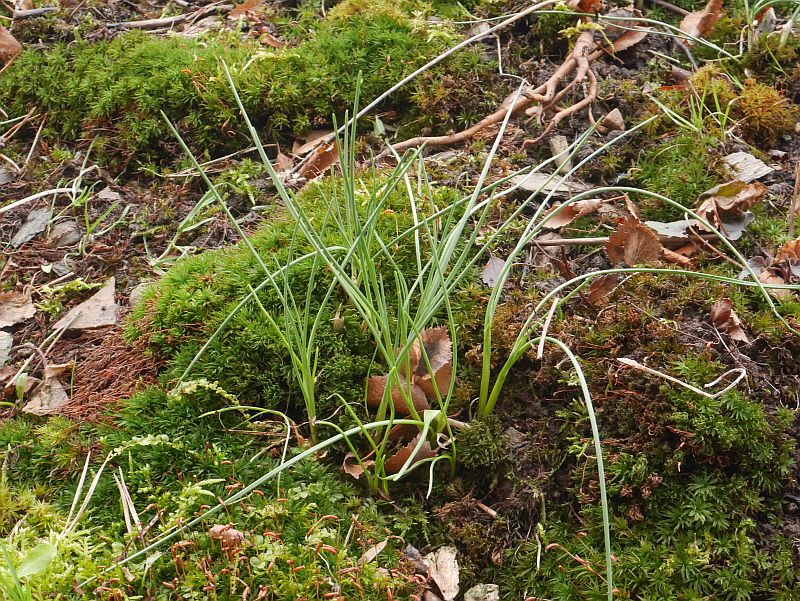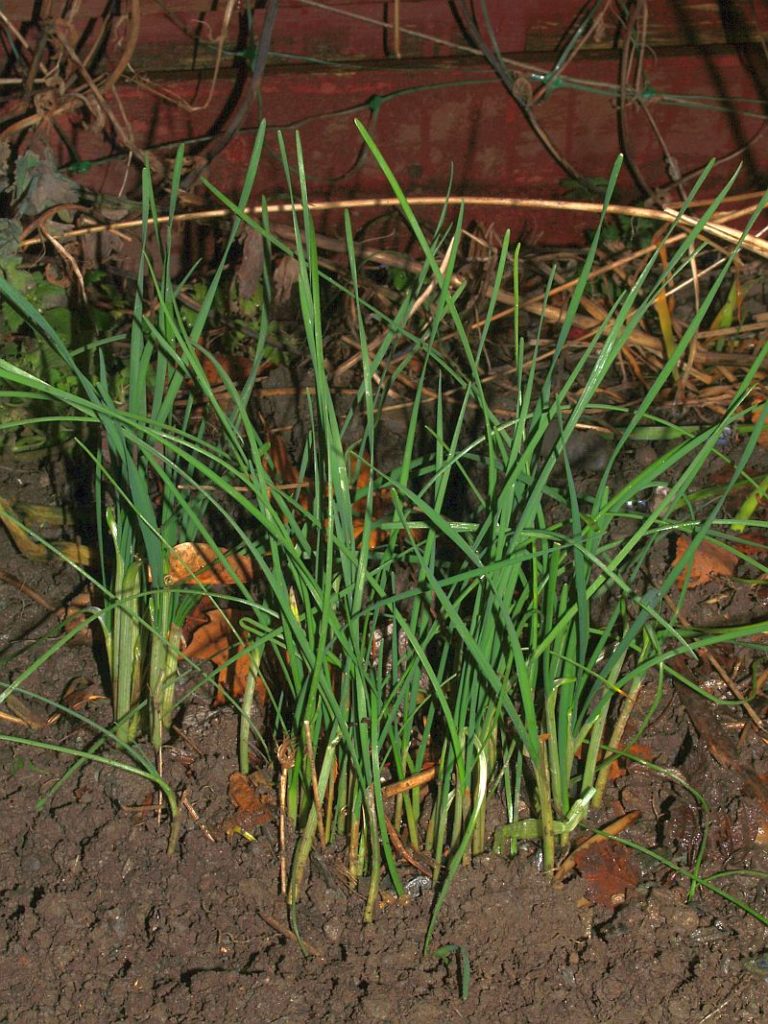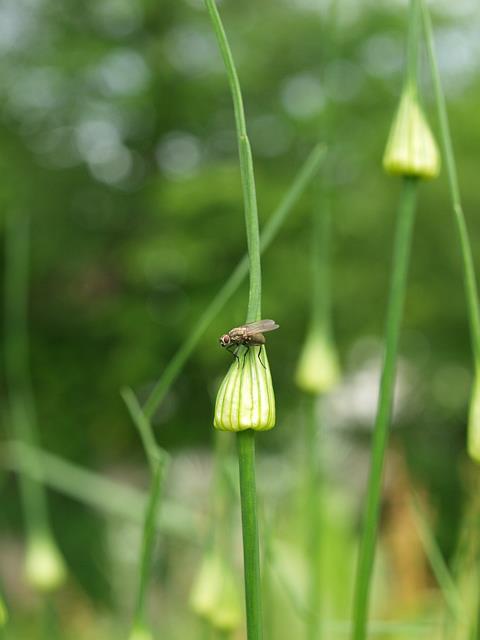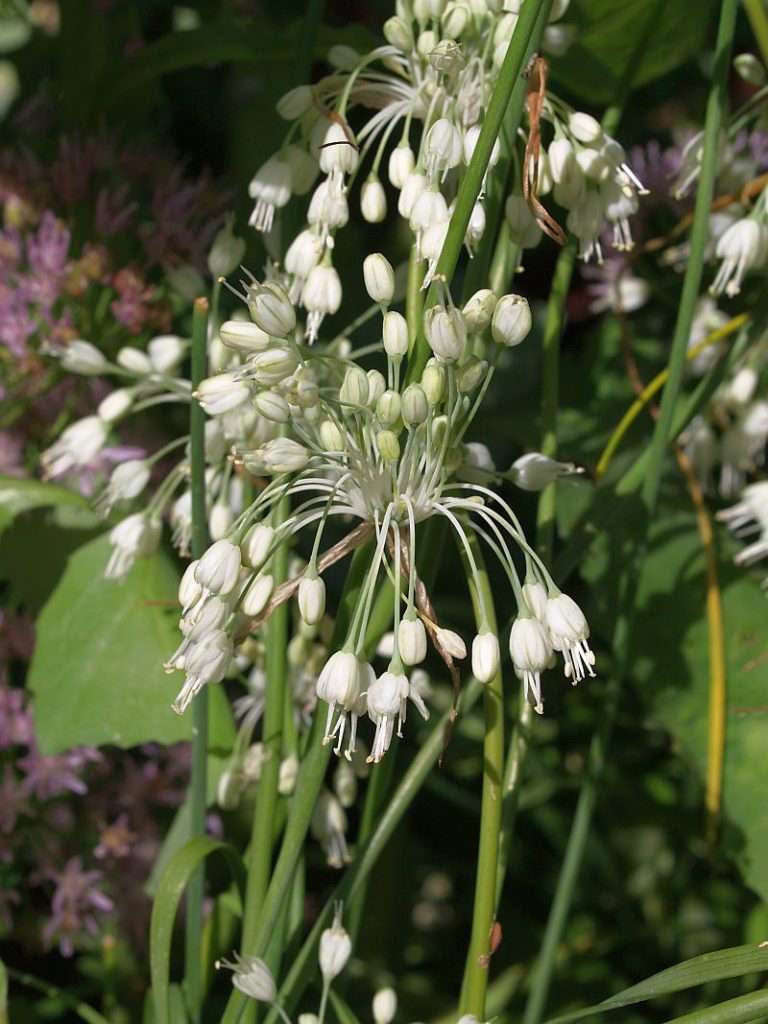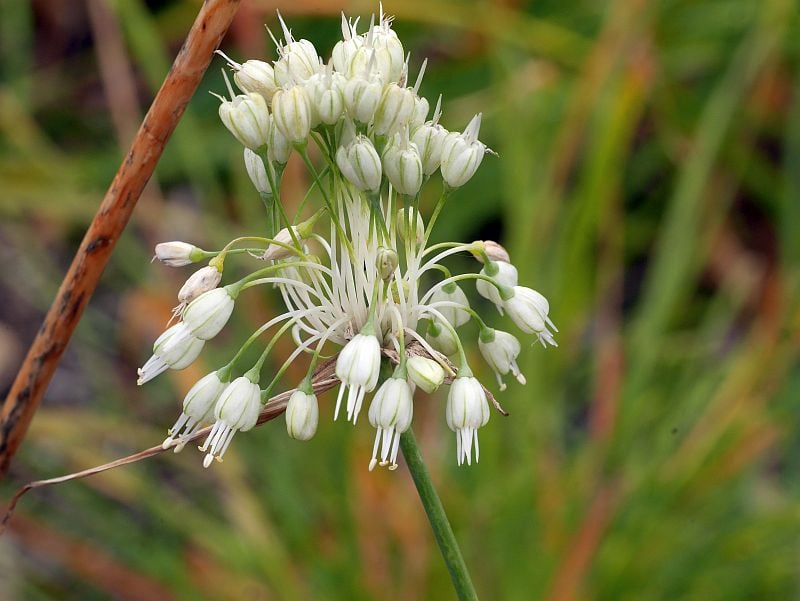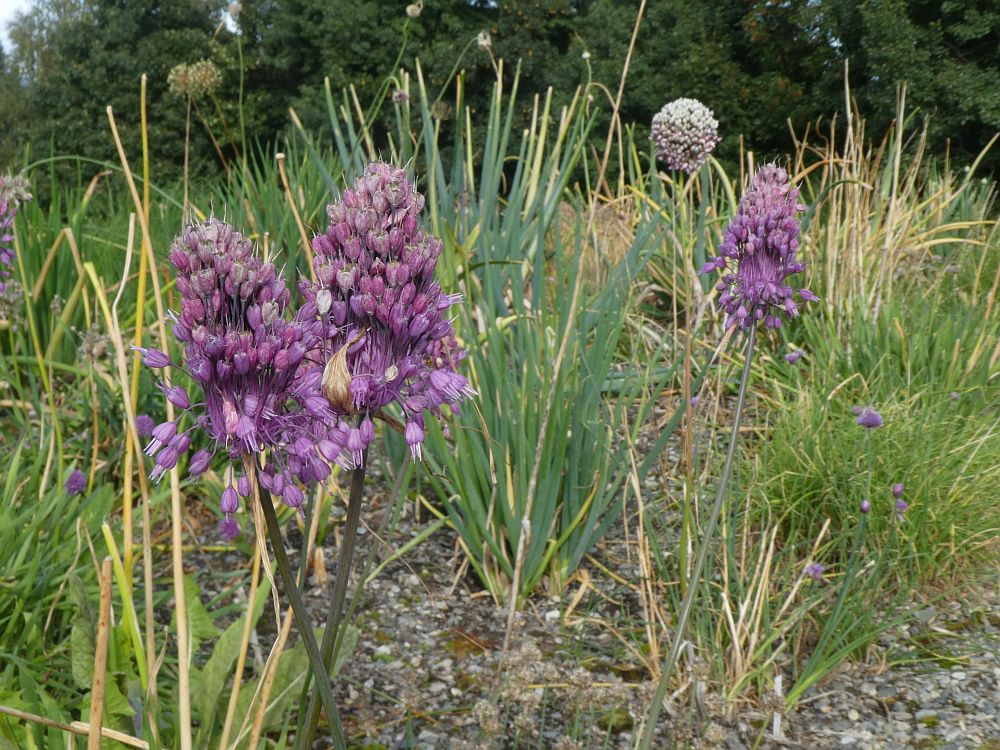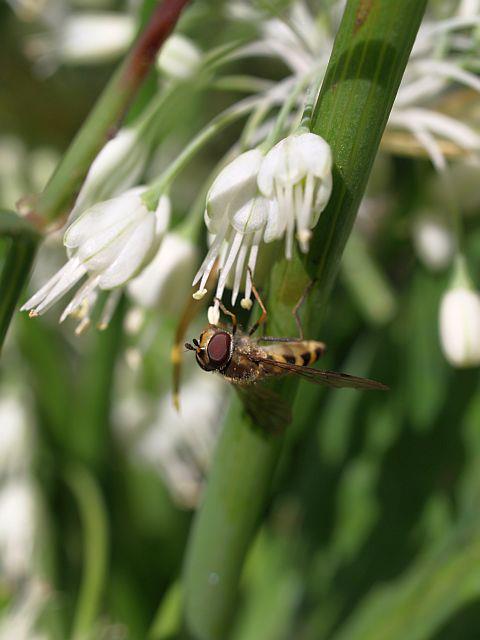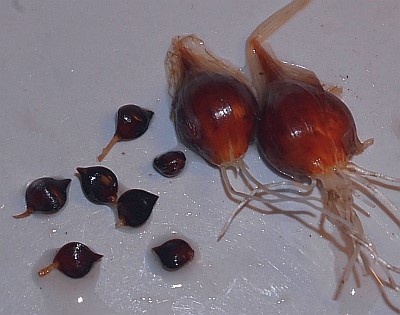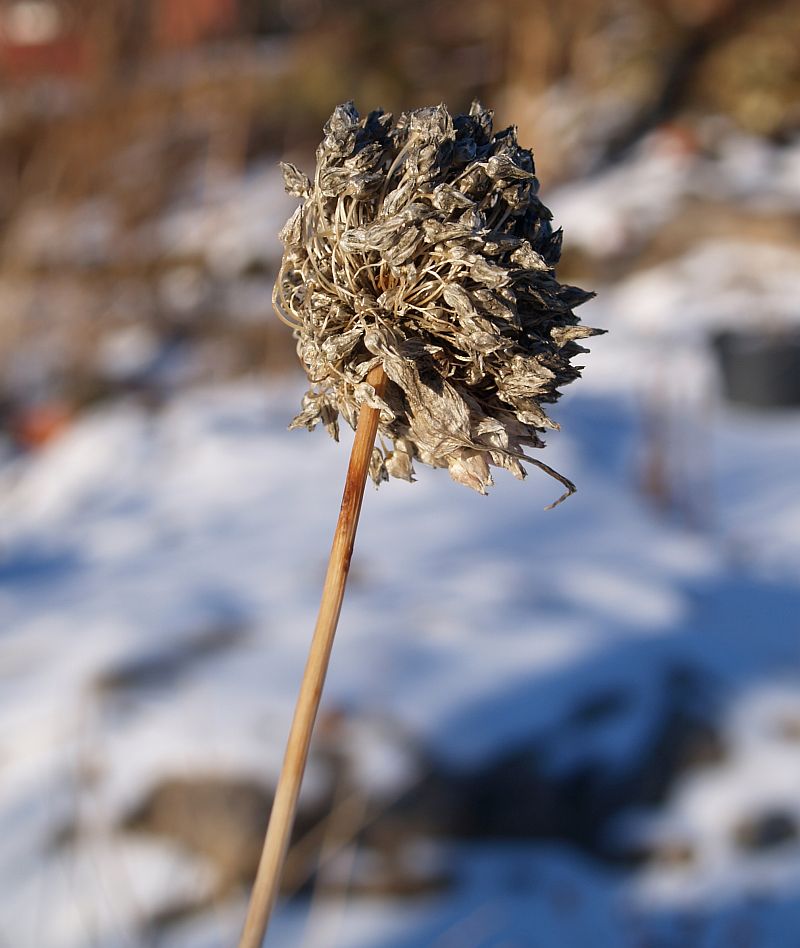

Various Allium species are the hardiest of edible plants either staying green all winter (e.g., Allium cernuum and Allium carinatum) or sprouting very early and able to withstand some frost. With a minimum forecast of -6C tomorrow after a very mild March, it will be interesting to see whether any of these early shooters are damaged. Here are a selection of pictures of Alliums and other early spring shoots in this weeks snow.
Category Archives: Onions
Harvesting midwinter nodding onions
Allium cernuum (nodding onion / prærieløk) is hardy more or less anywhere people live and stays green all winter here. It’s been mild with snow coming and going for several weeks and there’s no frost in the soil. I dug up a clump yesterday to use in the kitchen and replanted a few. Some were used in a salad and others will be used in any dishes with onion in the next couple of weeks (Indian, Chinese, Mediterranean pasta with green sauce….anything really).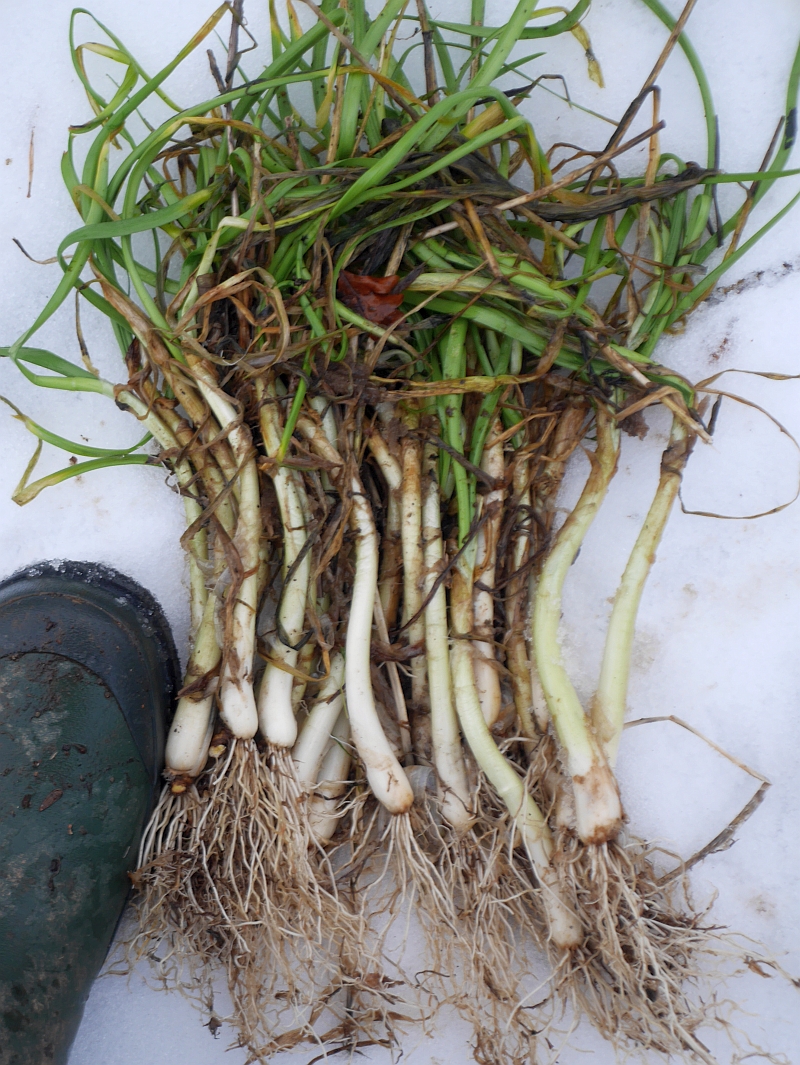
Chiugok, Small Bird’s Garlic, a hardy Himalayan edimental
Like Sherpa onion or Nepalese onion Allium wallichii, which features in my book Around the World in 80 plants, chiugok (small bird’s garlic) as Allium macrantum is known in Lithang, Tibet is the latest emerging Alliums in my garden. I often wonder if they are still alive when, in a cold spring they haven’t emerged by the end of May, but both species have overwintered now for almost 20 years.

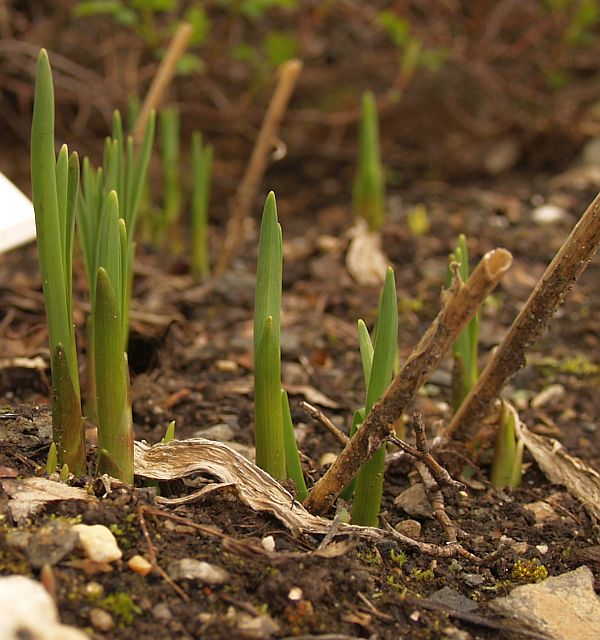
I’m not sure where my oldest plants came from but my second accession came from Vojtec Holubec’s seedlist, collected in Szechuan in China. It’s native to Bhutan, Sikkim, Gansu, Shaanxi, as well as Szechuan and Tibet and grows in wet places at elevations of 2700–4200 metres (Flora of China).
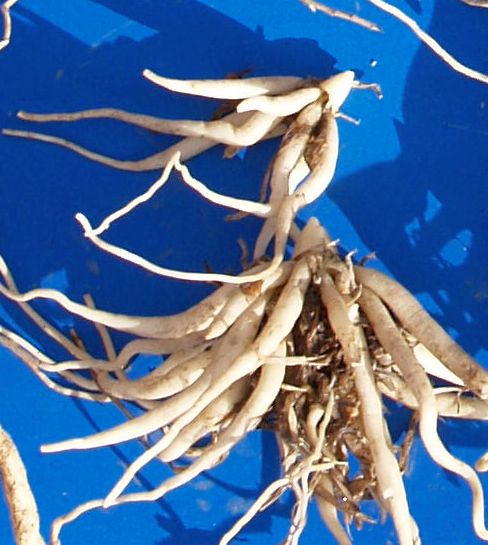
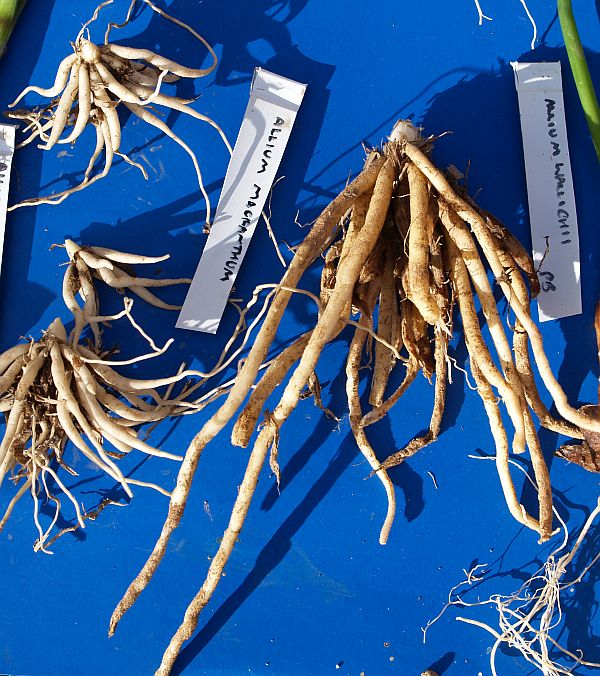
By early July the old roots are withering away and new roots are growing as the flower scape appears:

The flowers are gorgeous hanging on long pedicels. Note that the flower colour varies and the Szechuan accession is pink with green pedicels and has relatively many flowers.
One of my multi-species salads with Allium macranthum flowers in the centre:
Seed heads on 6th September:
Seeds ready to share or trade:
Ethnobotanical records
I searched Google Scholar for evidence of Allium macrantum being used traditionally for food and there were indeed a few ethnobotanical studies recording its use as a food plant. Although not the most popular food Allium in the Himalayas, it is reported to have been one of several species eaten both in Arunachal Pradesh in North East India, the Eastern Hills of India (along with more commonly used Allium wallichii, Allium hookeri and Allium fasciculatum) and used as a spice with meat in South Central Tibet. In Lithang, chiugok “is cleaned and cut into small pieces. It is mixed with butter, tea, roasted barley flour (tsampa), salt, and chilly. Tsampa may not be added. The sauce so obtained is eaten with Tibetan dumplings (mokmok) and fried meat-filled pancakes (shapakle)” (in Traditional knowledge of wild food plants in a few Tibetan communities).
The taste is in my experience relatively strong and therefore best in mixed salads and cooked dishes.
Allium macranthum has also been moved into gardens as an ornamental and has also been used medicinally, including, along with other Allium species, as a cure for altitude sickness!
Tall Swamp Onion
Years ago, I was at a work meeting in San Francisco with my colleague Harald Krogstad who sadly died in 2020. It’s very easy to put a date on this as we flew back on the day of the September 11 attacks, almost 20 years ago. After the meeting we hired a car and drove up to the Sierra Nevada and walked for a couple of days in the Tuolumne Meadows area. I remember finding a patch of a large Allium that I later found out had to be the tall swamp onion or Pacific onion (Allium validum). A few seeds from those plants later germinated in Malvik and this became one of the 80 plants in my book Around the World in 80 plants. A few years ago I renovated my pond area and associated damp area where I was growing this onion which grows in large clumps in damp meadows at elevations of 1200-3350 m in the Sierra Nevada. It was finally possible to harvest again this year and yesterday I used it in scrambled eggs. The flowers umbels are unusually small for such a large Allium and for that reason has never become popular as an ornamental. See an earlier blog post with pictures that didn’t make it into the book here: https://www.edimentals.com/blog/?page_id=5994
Allium ulleungense: a new vigorous edimental
In 2019, a very interesting paper was published giving a very good case for splitting the geographically widespread Allium victorialis species complex, at the same time describing a new endemic species to the island Ulleung between Korea and Japan. The paper also mentions that the species is “Rare in natural habitats, but widely cultivated in Korea as an edible plant named ‘Myeong-i-na-mul’ or ‘Sanmaneul.’”
Reference: “Allium ulleungense (Amaryllidaceae), a new species endemic to Ulleungdo Island, Korea” by Hyeok-Jae Choi, Sungyu Yang, Jong-Cheol Yang and Nikolai Friesen in the Korean Journal of Plant Taxonomy
Those who follow my blog and FB posts will maybe remember my article on the Giant Ulleung Celery, Dystaenia takesimana, another edible endemic to this island which I’m growing in my garden from two sources, one of which is the Gothenburg Botanical Gardens in Sweden (see http://www.edimentals.com/blog/?p=24998)
Figure 4 in the paper (below) shows a map of Allium subg. Anguinum showing the disjunct distribution of what was earlier classified as Allium victorialis, now split into Allium victorialis, microdictyon, ochotense and the new species Allium ulleungense together with other species in the section like Allium ovalifolium.
The article has a useful table and pictures showing the differences between microdictyon, ochotense and ulleungense.
I have about 10 different “Allium victorialis” accessions in my garden both from Norway, Kola (Russia), the Alps and the Far East. Having read the paper which documents that the Ulleung victory onion has both broader and longer leaves I noticed that one of my plants had very different and broader leaves than my other ones and was particularly vigorous. I had lost the label of this plant. Johan Nilson of the Gothenburg Botanical Garden wrote on the Alliorum forum thread about this species: “I believe we might grow this” (they had had an expedition to the island some years ago and this onion and Dystaenia had been collected). Johan had given me various edibles on a visit to Gothenburg a few years ago and I wonder if he might have given me this plant?
Anyway, the morphology of this plant fits well to the newly described species with several leaves 12 cm wide (ochotense reaches 10 cm and microdictyon 6 cm); leaves up to 26-27 cm long (the other two species reach 25 and 21.5cm) and yesterday I measured the white tepals which are slightly longer in the new species and this also matched with 7mm length (the others reaching 6.5). The rounded leaf apex of my plant also matches ulleungdense, acute in the other two species (and other Japanese accessions I have in my garden). I now need to propagate it and plant it in the Allium garden Chicago at the Ringve Botanical Garden.
Unintentional presents
Yesterday was my birthday and the best presents were all unintended as birthday presents:
1. Allium victorialis from a large stand that has naturalised from a farm garden in Nordland county, Norway to be offered to various members of KVANN (Norwegian Seed Savers) when I get time (From Inger Elvebakk, who also took the picture):
2. A new sea kale / strandkål (Crambe maritima) accession from a KVANN member, from a wild population
3. Decorah Posten took over a month to get here, but it arrived too on my birthday (see https://en.wikipedia.org/wiki/Decorah_Posten); more about this another time!
Still green after the freeze
Since New Year, only one day had been slightly above zero with temperatures regularly below -15C, but then a big shift in the weather happened a few days ago and it’s now 25C warmer than it was a week ago!
It’s interesting to see how hardy some Alliums are, even when not insulated by snow and here are 3 of the most hardy: Allium carinatum (keeled garlic / rosenløk), Allium flavum (small yellow onion / doggløk) and Allium cernuum (nodding onion /prærieløk) can all be harvested even though the soil is frozen solid. Hablitzia tamnoides (Caucasian spinach / stjernemelde) shoots are also developing nicely and I’ll have a few for lunch today along with the onions.
Keeled garlic, a useful winter Allium and edimental in summer
There are Allium species that can be harvested year round in the garden, notably nodding onion / Norw:prærieløk (Allium cernuum) which I’ve blogged about before. In autumn, new shoots of Allium carinatum subsp. pulchellum (keeled garlic / Norw: rosenløk) appear and with the mild weather we’ve been experiencing they’ve already reached about 20 cm high. They are hardy and can survive to at least -20C. It’s now in the autumn that this edimental Allium is most useful. I use the shoots in a similar way to chives (Allium schoenoprasum), which died back some time ago and won’t reappear until spring (unless I force them indoors), in salads, cut and sprinkled on sandwiches, in scrambled egg, quiches etc. I use them from October to April.
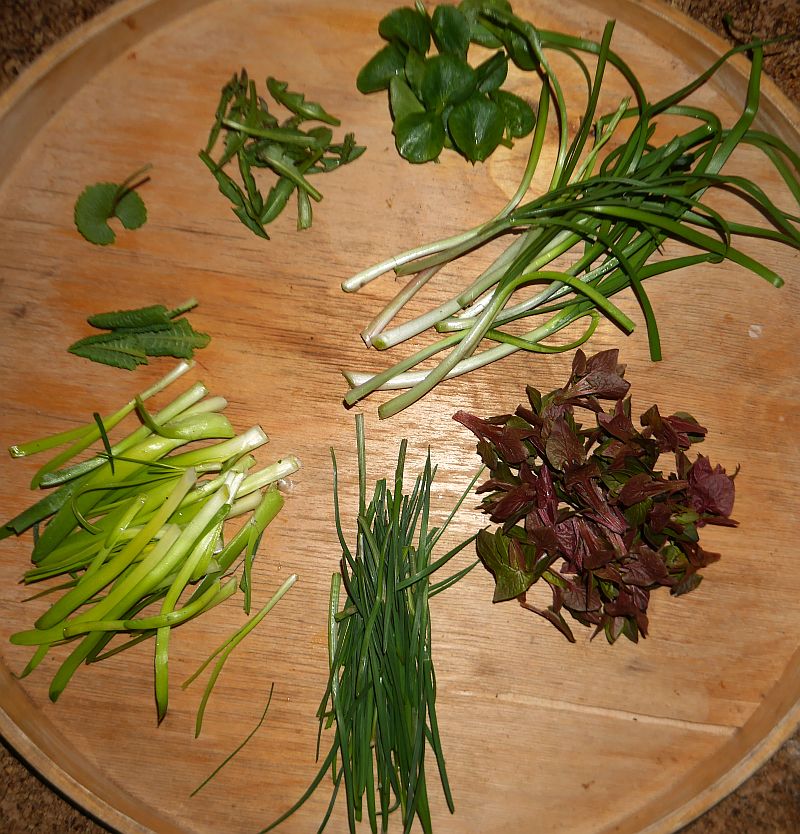
There are two colour forms, pink and white which are particularly valuable as they last such a long time and are popular with pollinators:
There are also forms with bulbils which can be a bit invasive:
You’ll see the flowers used as a tasty decoration in my multi-species salads (bottom right in the picture):
Allium carinatum is also popular with pollinators:
Red-tailed bumblebee: new species for the garden
Yesterday, I registered red-tailed bee / steinhumle (Bombus lapidarius) for the first time at the community garden (Væres Venner), the first time in this part of Trondheim. This is a common species in the city and is probably the commonest bumblebee in the Allium garden at the botanical gardens. Today, I saw this species for the first time in my own garden, the first record in this area. It was on Allium pskemense, probably the most popular plant in my garden for bumblebees. In the second video you can see both the white-tailed bumblebee (Bombus lucorum; lys jordhumle) and tree bumblebee (Bombus hypnorum; trehumle). Please correct me if I’m wrong!
Allium atroviolaceum?: Caucasian Turkish garlic
(Note that there is a comment suggesting that this isn’t atroviolaceum and is probably rotundum, although accessions I’ve received as that species are much lower plants; will check in the spring)
Allium atroviolaceum is sometimes cultivated as an ornamental. I’ve been growing it for some 15 years now and it is admittedly not very productive as an edimental under my conditions, but it’s nevertheless a beauty and it is currently coming into flower both in my own garden and the Allium garden at the Ringve Botanical Garden in Trondheim, where the pictures below were taken. Its wild distribution is in the Crimea, Caucasus, Middle Asia (Mountainous Turkmenistan, Syr-Darya foothill areas) and Iran.
In the Armenian Highlands in Eastern Turkey, there are several ethnobotanical studies documenting its use in local food, presumably wild collected, although there are indications that it might also be cultivated for food including:
1) In otlu peyniri, a herbed cheese made out of sheep’s or cow’s milk. it is used as a flavouring along with many other species (from Wikipedia):
Ranunculus polyanthemos L.(Ranunculaceae)
Nasturtium officinale R. Br. (Brassicaceae)
Gypsophila L. spp. (Caryophyllaceae)
Silene vulgaris (Maench) Garcke var. vulgaris (Caryophyllaceae)
Anthriscus nemorosa (Bieb.) Sprengel (Apiaceae)
Carum carvi L. (Apiaceae)
Anethum graveolens L. (Apiaceae)
Prangos pabularia Lindl. (Apiaceae)
Prangos ferulacea (L.) Lind. (Apiaceae)
Ferula L. sp. (Apiaceae)
Ferula orientalis L. (Apiaceae)
Ferula rigidula DC. (Apiaceae)
Thymus kotschyanus Boiss. et Hohen. var. glabrescens Boiss. (Lamiaceae)
Thymus migricus Klokov et Des. – Shoct. (Lamiaceae)
Mentha spicata L. subsp. spicata (Lamiaceae)
Ziziphora clinopodioides Lam. (Lamiaceae)
Ocimum basilicum L. (Lamiaceae)
Eremurus spectabilis Bieb. (Liliaceae)
Allium schoenoprasum L. (Liliaceae)
Allium fuscoviolaceum Fomin (Liliaceae)
Allium scorodoprasum L.subsp. rotundum(L.)Stearn (Liliaceae)
Allium aucheri Boiss. (Liliaceae)
Allium paniculatum L. subsp. paniculatum (Liliaceae)
Allium akaka S. G. Gmelin (Liliaceae)
Allium cf. cardiostemon Fisch. et Mey. (Liliaceae)
2) In another study, the young shoots are used in various dishes and as a flavouring with yoghurt. It us used both boiled and raw. The bulbs are used to replace garlic in food.
Local names in Turkey include sirmo, körmen, and yabani sarimsak.



